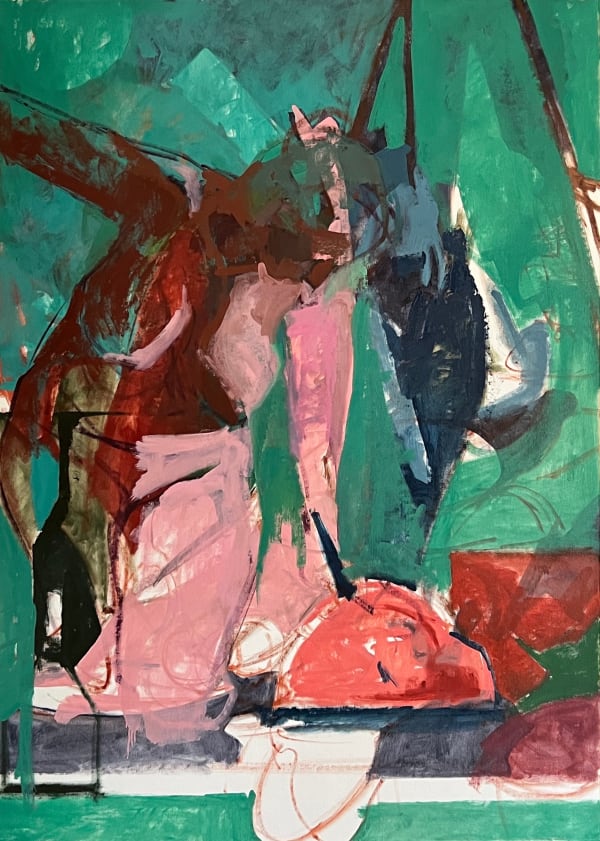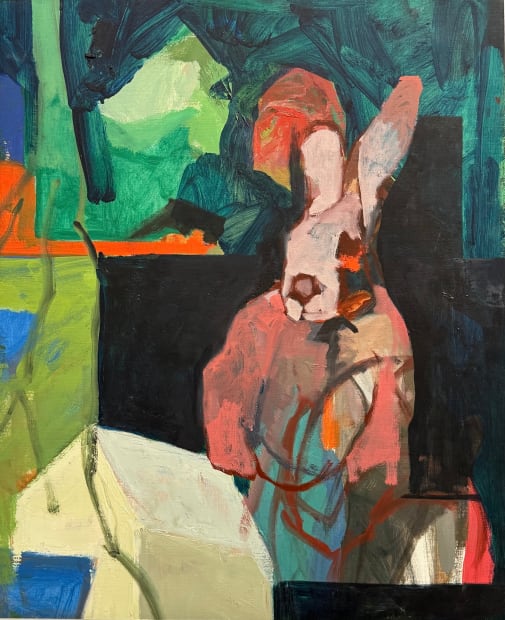-
Where I'm Calling From: Jennifer Agricola Mojica
San Antonio -
Ruiz-Healy Art is pleased to present Where I’m Calling From: Jennifer Agricola Mojica, a solo exhibition featuring the work of San Antonio-based artist Jennifer Agricola Mojica. The exhibition marks her third exhibition with the gallery and her first solo exhibition with Ruiz-Healy Art. Where I’m Calling From explores personal narrative, fragmented memory, and art historical dialogue through a dynamic oil painting process wherein objects and figures walk the line between abstraction and figuration.
-
 Jennifer Agricola MojicaNobody Said Anything, 2023Oil on linen50 x 48 in
Jennifer Agricola MojicaNobody Said Anything, 2023Oil on linen50 x 48 in
127 x 121.9 cmJennifer Agricola Mojica is an artist and educator based in San Antonio, Texas, whose work explores themes of transience, time, and fragility as a way to digest personal experiences and larger societal issues. Her oil painting practice unfolds through multiple stages, involving layering, shaping, and dismantling the compositional space; visual planes, figures, and objects are interrupted and disordered.Agricola Mojica explores themes of rest, vulnerability, and maternal instinct. In Nobody Said Anything, she references the historical painting, Massacre of the Innocents by Nicolas Poussin, recontextualizing classical compositions to reframe the mother figure not as a victim but as a protector and caregiver. She creates dialogues between appropriation and abstraction, using the language of Old Masters while disrupting traditional narratives of gender and power.
-
Agricola Mojica challenges traditions of figurative painting - creating visceral portraits of women with a distinct intuitive and gestural immediacy. Her work blends the concepts of Cubism, the immediacy of abstract expressionism, and the exuberance of Baroque styles- her fleshy, voluptuous women inhabit multiple planes.
-
“In Rabbit, the figure began with gestural marks and gradually emerged through overlapping shapes. Baroque still life elements appear and recede, pressing up against contemporary painterly approaches. The figure reaches for a steak but can’t touch it. She shouldn’t or couldn’t have this desire. This piece, like many others, is a conversation between conscious intention and unconscious longing.” - Jennifer Agricola Mojica.
-
 Jennifer Agricola MojicaThings Keep Falling, 2025Oil on canvas30 x 40 in
Jennifer Agricola MojicaThings Keep Falling, 2025Oil on canvas30 x 40 in
76.2 x 101.6 cm -
As both an artist and an educator, Agricola Mojica often revisits art history to build a curriculum and a basis for her artworks. She often begins with a master study, such that in the case of Still Life with Grapes. Symbols in the artist’s work are repeated to the point of exhaustion throughout multiple compositions and bodies of work. Her figures are often layered, distorted, and re-worked, utilizing her time and technique to self-reflect on loss and protection. The artists states,"I deconstructed my students’ vanitas still-life, pulling aside one of the props – a black crow. I used it for a small painting demo and then became fixated on it for several paintings. The crow became a powerful image for me. In all my paintings, forms, figures, and objects are covered, buried, or obliterated.”
-
-
Recurring motifs, such as birds, houses, fishes, rabbits, and plants, have become integral to her symbolic vocabulary, first emerging in the studio during the COVID-19 pandemic's remote-learning era. These objects now serve as metaphors for protection, loss, safety, and failure, particularly the tender act of trying and sometimes failing to sustain life. Houseplants, often depicted mid-wilt or decay, reflect cycles of growth and surrender.
-
“These accumulated layers function like skin, holding and containing the painting’s history while allowing glimpses of its foundation to show through.” - Jennifer Agricola Mojica
-
Agricola Mojica’s recent work has transitioned to representing moments of rest and tranquility. In I Can Hear My Heart Beating, the themes of rest and stillness speak to the artist’s lived experience and her interrogation of femininity, selfhood, and care. She creates familiarity among a sense of unease, alluding to experiences of parenting, educating, and creating. The title is indicative of physical sensations and rhythms such as breath and heartbeats.
-
“These paintings offer no resolution. They embrace the discomfort of ambiguity.” - Jennifer Agricola mojica
-
 Jennifer Agricola MojicaLupe's Wedding Plate, 2025Oil on paper16 x 12 in
Jennifer Agricola MojicaLupe's Wedding Plate, 2025Oil on paper16 x 12 in
40.6 x 30.5 cm -
In the painting, I’m Not From Here, she creates an overwhelming disorder that gives way to a sense of stillness; the parts sublimate into a cohesive whole as the artist “weaves concepts and elements together,” a process she describes as “calm and meditative.” The exploration of the self as multiple parts of a whole continues to be a primary influence in Agricola Mojica’s work.
-
 Jennifer Agricola MojicaBelonging, 2024Oil on paper22 x 18 in
Jennifer Agricola MojicaBelonging, 2024Oil on paper22 x 18 in
55.9 x 45.7 cm -
 Jennifer Agricola MojicaDo You Want to Go or Don’t You?, 2021Oil on Canson Canva Paper28 x 35 in
Jennifer Agricola MojicaDo You Want to Go or Don’t You?, 2021Oil on Canson Canva Paper28 x 35 in
71.1 x 88.9 cmThe artist draws on themes and subjects relevant to the Bay Area Figurative School, including subjects such as the figure, still life, and landscape. In Do You Want to Go or Don’t You?, Agricola Mojica appropriates Elmer Bischoff’s Two Figures at the Seashore; Bischoff, a pioneer of the post-war Bay Area Figurative Movement, merged the gestural immediacy of then-prevailing abstract expressionism with figurative and narrative subjects. Much like Bischoff, she draws from visual memory and metaphysical sensations in composing her pictures, which include unspecified interiors and figures.
-
 Jennifer Agricola MojicaDislocated, 2025Oil on canvas35 x 28 in
Jennifer Agricola MojicaDislocated, 2025Oil on canvas35 x 28 in
88.9 x 71.1 cm
Where I'm Calling From: Jennifer Agricola Mojica: San Antonio
Current viewing_room
















